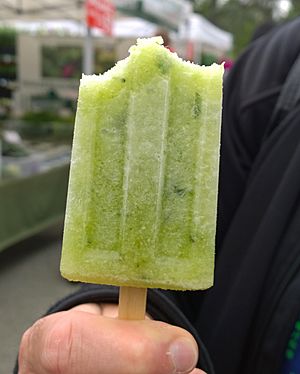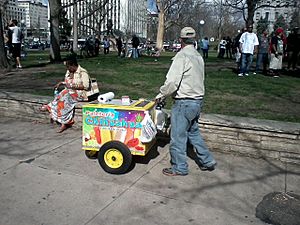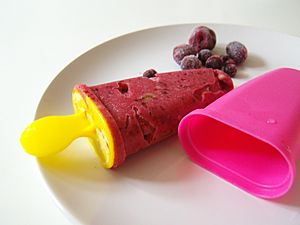Ice pop facts for kids

A cucumber, elderflower and mint ice pop.
|
|
| Alternative names | Popsicle, paleta, ice lolly, icy pole, ice block, ice drop, ice gola, ice candy |
|---|---|
| Type | Frozen dessert |
| Place of origin | United States |
| Region or state | California |
| Created by | Frank Epperson |
| Main ingredients | Water/milk and flavoring (such as fruit juices or chocolate ice cream) |
| 200 kcal (837 kJ) | |
An ice pop is a yummy frozen treat on a stick! It's made from liquid, like fruit juice or a sweet drink, that gets frozen solid. Unlike ice cream, which is whipped to make it creamy, an ice pop freezes still. This gives it a cool, icy texture.
The stick is super handy for holding your ice pop without getting sticky hands. If it didn't have a stick, it would be called a freezie. Most ice pops you buy have added sugar and other ingredients. But you can also find options with fewer calories.
Ice pops have many different names around the world! In Canada and the United States, people often call them popsicles. This is actually a brand name! In Mexico, they're known as paletas. In the United Kingdom and Ireland, they're ice lollies. People in Australia and New Zealand call them ice blocks or icy poles. In the Philippines, they're ice drops or ice candy. And in India, they're called ice gola or ice candy.
Contents
Who Invented the Ice Pop?
Have you ever wondered who invented the ice pop? It's a pretty cool story!
Early Frozen Treats on a Stick
Long ago, in 1872, two men named Ross and Robbins sold a frozen fruit treat on a stick. They called it the "Hokey-Pokey." So, frozen treats on sticks have been around for a while!
Frank Epperson's Accidental Discovery
The ice pop we know today became super popular thanks to a boy named Frank Epperson. He lived in Oakland, California. Frank said he first made an ice pop by accident in 1905. He was only 11 years old!
He left a glass of powdered lemonade soda and water outside on his porch. It had a mixing stick in it. That night, it got really cold, and the drink froze solid! This story is even printed on the back of Popsicle boxes today.
From Accident to Invention
Years later, when Frank was a grown-up lemonade salesman, he remembered his accidental invention. In 1922, he shared his frozen treat at a fireman's ball. People loved it!
In 1923, when Frank was 29, he got a special paper called a patent for his "Epsicle" ice pop. A patent means he officially owned the idea of "frozen ice on a stick." He first sold his Epsicles in seven fruit flavors at Neptune Beach amusement park. He called them "frozen lollipops" or "drinks on a stick."
A few years later, Frank sold the rights to his invention and the Popsicle brand. He sold them to a company in New York City.
Different Names for Ice Pops Around the World
As we learned, ice pops have many names! Let's look at some of them.
Popsicle: A Popular Brand Name
In the United States and Canada, many people say "popsicle." This is because the Popsicle brand was very popular early on. But remember, "Popsicle" is a registered trademark. It's like saying "Kleenex" instead of "tissue."
The word "popsicle" is a mix of "pop" (like a lollipop) and "icicle." It's such a common word that people even use it in other sayings!
Ice Lolly and Ice Block
In Ireland, "ice pop" is the main name. In the United Kingdom, they say "ice lolly." They use "ice pop" for a freezie, which is flavored ice in a tube without a stick.
In Australia, you'll hear "ice block" or "icy pole." "Icy Pole" is also a brand name there. New Zealanders also say "ice block."
Ice Drop and Ice Candy
In the Philippines, they call them "ice drops." If it's coconut flavored, it's an ice buko. In India and Japan, they use the terms "ice gola" and "ice candy."
Paleta: A Special Mexican Treat
Paletas are a special kind of ice pop from Mexico. The word "paleta" means "little stick."
The Paleta Story
In the early 1940s, a man named Ignacio Alcázar visited the United States. He got the idea to make ice pops using fresh fruit from his hometown of Tocumbo, Mexico.
He and his family opened a shop in Mexico City. It became very popular! Ignacio started letting friends and family from his town open their own shops called Paletería La Michoacana. Paletas became so famous that they are now a national Mexican food!
What Flavors Do Paletas Have?
Paletas come in two main types: milk-based or water-based. Most of them are made with fruit. Paleterias (paleta shops) often have tons of flavors! You might find local Mexican flavors like horchata (a rice drink), tamarind, mamey, and nanche. They also have classic flavors like strawberry, lime, chocolate, and mango.
Sometimes, paletas have unique Mexican ingredients like chili pepper, chamoy (a tangy sauce), and vanilla. Paleterias often change their flavors to match what people in the area like and what ingredients are available.
Paletero: The Ice Pop Seller

A paletero is like an "ice cream man" but for paletas! They sell paletas and other frozen treats from a pushcart. These carts usually have the name of the company that made the paletas. You can find many paleteros in American cities that have a lot of Mexican people.
How to Make Ice Pops at Home
You don't have to buy ice pops from a store! You can easily make them at home.
You can use fruit juice, drink mixes, or any freezable drink. A simple way is to pour the liquid into ice cube trays and add toothpicks. You can also buy special ice pop molds that make perfect shapes!
Cool Ice Pop Inventions
In 2018, a design company in the UK called Bompas & Parr announced something amazing. They created the world's first "non-melting" ice pop!
Well, it does melt, but much slower than regular ice pops. This is because it has tiny strands of fruit fibers inside. These fibers make the ice pop thicker. The thicker an ice pop is, the slower it melts! This idea was inspired by a material called pykrete.
World Record Ice Pop Attempt
On June 22, 2005, a company called Snapple tried to set a new world record. They wanted to make the biggest ice pop ever! The old record was a 21-foot-long ice pop from 1997.
Snapple tried to build a 25-foot-long ice pop in New York City. It weighed 17.5 tons (that's like 35,000 pounds!) of frozen juice. But the giant ice pop melted much faster than they expected. People had to run to higher ground as firefighters hosed away the melted juice. They didn't get the new record that day!
See also
 In Spanish: Paleta (helado) para niños
In Spanish: Paleta (helado) para niños
- Creamsicle
- Freezie—a frozen treat without a stick
- Ice cream
- Ice cream bar—like an ice pop, but made with ice cream
- Lollipops
- Sorbet


